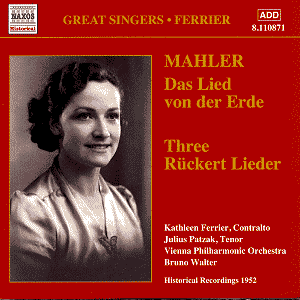Comparison issues:
Mahler, Das Lied von der Erde, with Kathleen Ferrier, Julius
Patzak, Vienna Philharmonic Orchestra/Bruno Walter (Decca 414 194-2)
Mahler, Three Rückert Lieder, Kathleen Ferrier, Julius Patzak,
Vienna Philharmonic Orchestra/Bruno Walter (Decca 433 477-2)
This classic recording is a precious record of Ferrier’s
singing, and certainly belongs on every vocal collector’s shelves; certainly
those of every Mahlerian. Legitimate questions have been raised as to
whether this would be Mahler’s favourite version if he were here to
give recommendations; I say probably not. I would never part with my
Kirsten Thorborg/Charles Kullman Das Lied. Maureen Forrester
also sounds pretty good even compared to Ferrier. Patzak’s contribution
in Das Lied ranges from good to awful. Even his best cannot compare
with the best of Kullman, Dermota, Wunderlich or even Richard Lewis.
In Der Abschied, Ferrier’s tragedy is a fully adult emotion,
whereas Thorborg is able to capture the hurt, bewildered, child-like
‘why do you have to go away Mommy?’ feeling. Thorburg even manages the
child-like, momentary delight at the beauty of the rising moon, whereas
Ferrier’s morbidity is unvaried. It will hopefully be at least five
years before my cancer gets to the point where Ferrier’s was then; as
that time draws nearer I may find this recording more personally relevant.
The ascription ‘ADD’ which is on the liner notes to
the Naxos disk may mislead. This is actually an AAADD production, since
there are two additional analogue transfer processes in the chain. The
ADD CD issued by Decca made from the original master tape has in the
chain three analogue transfer processes: from air pressure wave to electrical
signal, electrical signal to tape recording, then to tape playback,
and finally to digitisation (Assuming of course that the master tape
was not copied at any time). In the Obert-Thorn transfer there are two
additional transfers, from master tape to disk-cutter and disk playback
to digitisation. Each of these five transfers degrades and changes the
signal detectably. In addition, Obert-Thorn has used digital processing
to remove surface noise — vinyl scrape and clicks-and-pops — and my
practised ear can detect the residual artefacts of these both.
The question is, are these degradations really noticeable?
I have to say not very. In a direct A/B comparison, I can hear them,
probably you couldn’t. Some people will inevitably think the transfer
sounds better. Obert-Thorn has done an exceptional job, as usual. If
you have the original Decca CDs, of course you’ll keep them and be glad.
The original Decca CD of Das Lied is still available on Amazon.com
for £7, and this Naxos transfer sells there for £5. I can’t imagine
anybody buying the Naxos just to save £2, but maybe that’s OK by you.
But if some day the original is not available, then this transfer will
do just fine. Additionally, the Rückert Songs are not available
now from any other source, so for them we have no choice, and we can
be very satisfied with this transfer, secure in our assurance that the
transfer sounds very much like the original.
In the Naxos liner notes we are told that ‘There is
no over-reverberant ‘cathedral sound’ in an Obert-Thorn restoration
nor is there the tinny bass and piercing mid range of many "authorised"
commercial issues. His transfers preserve the original tone of the old
recordings...’ Philosophically speaking, I don’t think the transfer
engineer owes anything to the ‘original tone of the old recording’ but
only to the music. My philosophy is that if the original can be improved
upon, it is the duty of the transfer engineer to do it. For instance,
in restoring some Fernando Valenti original recordings I was able to
remove from the background some hum and air conditioner fan noise present
in the studio, and hence end up with a transfer that was noticeably
clearer and more transparent than the original. In restoring a Mahler
orchestral song, I was able to remove the sound of a dropped clipboard
from a quiet passage. In restoring a very dry Westminster Lab recording,
I did it with - and without reverb, and I think the ‘with’ is better,
but I offer you the choice to play it either way. And I restored the
clipped reverb tail from the end of the tape so the sound now dies smoothly
away to complete silence. So, sometimes a Shoemaker restoration might
be better than the original or an Obert-Thorn restoration, at least
in these specific ways.
Paul Shoemaker
Mark Obert-Thorn replies:
I think Mr. Shoemaker is reading a bit too much into
that "blurb" about my restoration philosophy. The point was merely to
differentiate my approach from those who add a great deal that is not
in the original recording. I certainly do try to remove extraneous noises
and hum, and add reverb (sparingly) when the originals sound so boxy
as to draw attention away from the music. Indeed, in the very disc he
reviewed, I corrected an editing error in "Um Mitternacht" (Ferrier
seemed to sing "mitternacht-cht" at one point) which was in every previous
"official" Decca LP and CD transfer!
